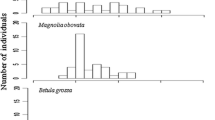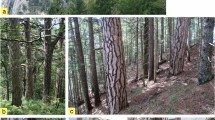Abstract
Size and age structure analysis were used to reconstruct the population dynamics of six apparently old and stable stands dominated by the conifers Libocedrus bidwillii and/or Dacrydium biforme in Camp Creek, Westland, New Zealand. All stands contained relatively even-aged groups of Libocedrus that had probably originated after either mass movement or windthrow. The age distributions of stands reflected the effects of disturbances 200–400 yr ago.
There was no evidence to support synchronous failure of regeneration of Libocedrus and Dacrydium biforme. Between 1600 and 1800 A.D., the period of the postulated conifer regeneration gap, over 70% of trees of these species had established. A lack of Libocedrus regeneration over the last 200 yr reflects a lack of disturbance over that time. Because of the dominating influence of disturbances and other factors it may be inappropriate to use tree population structures alone to substantiate or refute claims of recent climate change.
Similar content being viewed by others
References
Allen, R. B. & Wardle, J. A. 1985. Role of disturbance in New Zealand montane and subalpine forests. In: Turner, H. & Tranquillini, W. (eds), Establishment and tending of subalpine forest, pp. 151–157. Swiss Federal Institute of Forestry Research, Report 270.
Bathgate, J. L. 1981. Holloway's climatic change hypothesis — a quantitative evaluation in the Longwood forests. Ph.D. thesis, University of Canterbury, Christchurch, New Zealand.
Bray R. 1971. Vegetational distribution, tree growth, and crop success in relation to recent climatic change. Adv. Ecol. Res. 7: 177–233.
Brubaker L. B. 1986. Responses of tree populations to climatic change. Vegetatio 67: 119–130.
Burrows C. J. & Greenland D. E. 1979. An analysis of the evidence for climatic change in New Zealand in the last thousand years: evidence from diverse natural phenomena and from instrumental records. J. Roy. Soc. N.Z. 9: 321–373.
Clayton-Greene K. A. 1977. Structure and origin of Libocedrus bidwillii stands in the Waikato district. N.Z.J. Bot. 15: 19–28.
Cockayne L. 1928. Vegetation of New Zealand. 2nd ed.. W. Engelmann, Leipzig.
Cumberland K. B. 1962. ‘Climatic change’ or cultural interference? In: McCaskill M. (ed.), Land and Livelihood, pp. 88–142. Caxton Press, Christchurch, New Zealand.
Fleming C. A. 1963. Evidence for ecologically significant changes in climate during the post-glacial period in New Zealand. Proc. N.Z. Ecol. Soc. 10: 48–52.
Grant P. J. 1963. Forests and recent climatic history of the Huiarau Range, Urewera region, North Island. Trans. Roy. Soc. N.Z. (Botany) 2: 143–171.
Grant P. J. 1965. Major changes of the Tukituki River, Hawkes Bay, since about 1650 A.D. J. Hydrol. (N.Z.) 4: 17–30.
Holloway J. T. 1954. Forests and climates in the South Island of New Zealand. Trans. Roy. Soc. N.Z. 82: 329–410.
Holloway J. T. 1964. The forests of the South Island: the status of the climate change hypothesis. N.Z. Geog. 20: 1–9.
Hutchinson F. E. 1932. The life history of the Westland rimu stands. Te Kura Ngahere 3: 54–61.
Hytteborn H., Packham J. R. & Verwijst T. 1987. Tree population dynamics, stand structure and species composition in the montane virgin forest of Vallibäcken, northern Sweden. Vegetatio 72: 3–19.
Jane G. T. 1986. Wind damage as an ecological process in mountain beech forests of Canterbury, New Zealand. N.Z. J. Ecol. 9: 25–39.
June, S. R. 1982. Ecological studies in the indigenous forests of north Westland. Ph.D.thesis, University of Canterbury, Christchurch, New Zealand.
McKelvey P. J. 1953. Forest colonization after recent volcanicity at west Taupo. N.Z. J. For. 6: 435–448.
Molloy B. P. J. 1969. Evidence for post-glacial climatic changes in New Zealand. J. Hydrol. (N.Z.) 8: 56–67.
Nicholls J. L. 1956. The historical ecology of the indigenous forest of the Taranaki upland. N.Z. J. For. 7: 17–34.
Norton D. A. 1983. Population dynamics of subalpine Libocedrus bidwillii forests in the Cropp River valley, Westland, New Zealand. N.Z. J. Bot. 21: 127–134.
Ogden J. 1976. Notes on the influence of drought on the bush remnants of the Manawatu lowlands. Proc. N.Z. Ecol. Soc. 23: 92–98.
Ogden J. 1978. On the diameter growth rates of red beech (Nothofagus fusca) in different parts of New Zealand. N.Z.J. Ecol. 1: 16–18.
Ogden J. 1980. Dendrochronology and dendroecology — an introduction. N.Z. J. Ecol. 3: 154–156.
Ogden J. 1985. An introduction to plant demography with special reference to New Zealand trees. N.Z. J. Bot. 23: 751–772.
O'Loughlin C. L. & Owens I. F. 1987. Our dynamic environment. In: Holland P.G. & Johnston W.B. (eds), Southern approaches: Geography in New Zealand, pp. 59–90. New Zealand Geographical Society (Inc.), Christchurch, New Zealand.
Park G. N. 1970. Palaeoclimatic change in the last 1000 years. Tuatara 18: 114–123.
Robbins R. G. 1962. The podocarp-broadleaf forests of New Zealand. Trans. Roy. Soc. N.Z. (Botany) 1: 33–75.
Rose, A.B. 1985. The forests. In: Davis, M. R. & Orwin, J. (eds), Report on a survey of the proposed Wapiti area, West Nelson, pp. 68–109. N.Z.F.S., For. Res. Inst. Bull. 16.
Shaw W. B. 1983. Tropical cyclones: determinants of pattern and structure in New Zealand's indigenous forests. Pac. Sci. 37: 405–414.
Stewart G. H. & Harrison J. B. J. 1987. Plant communities, landforms, and soils of a geomorphically active drainage basin, Southern Alps, New Zealand. N.Z. J. Bot. 25: 385–399.
Stewart G. H. & Veblen T. T. 1982. Regeneration patterns in southern rata (Metrosideros umbellata)-kamahi (Weinmannia racemosa) forest in central Westland, New Zealand. N.Z. J. Bot. 20: 55–72.
Veblen T. T. & Stewart G. H. 1982. On the conifer regeneration gap in New Zealand: the dynamics of Libocedrus bidwillii stands on South Island. J. Ecol. 70: 413–436.
Walker, D. 1966. A commentary on botanical data from New Guinea, Australia and New Zealand. In: Sawyer, J. S. (ed.), Proc. of the Intern. Symp. on World Climate, pp. 149–153. Royal Meteorological Society.
Wardle P. 1963a. The regeneration gap of New Zealand gymnosperms. N.Z. J. Bot. 1: 301–315.
Wardle P. 1963b. Growth habits of New Zealand subalpine shrubs and trees. N.Z. J. Bot. 1: 18–47.
Wardle P. 1978. Regeneration status of some New Zealand conifers with particular reference to Libocedrus bidwillii in Westland National Park. N.Z.J. Bot. 16: 471–477.
Wardle P. 1979. Forest and climatic change — the status of the ‘Holloway Theory’. Ann. J. Roy. N.Z. Inst. Hort. 7: 133–144.
Wardle P. 1980. Primary succession in Westland National Park and its vicinity. N.Z. J. Bot. 18: 221–232.
Wardle P. 1985. Environmental influences on the vegetation of New Zealand. N.Z. J. Bot. 23: 773–788.
Author information
Authors and Affiliations
Rights and permissions
About this article
Cite this article
Stewart, G.H., Rose, A.B. Conifer regeneration failure in New Zealand: dynamics of montane Libocedrus bidwillii stands. Vegetatio 79, 41–49 (1988). https://doi.org/10.1007/BF00044847
Accepted:
Issue Date:
DOI: https://doi.org/10.1007/BF00044847




